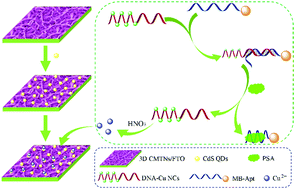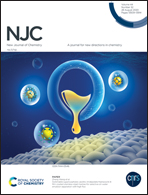Ultrasensitive photoelectrochemical sensor enabled by a target-induced signal quencher release strategy†
Abstract
In this work, a target-induced signal quencher release strategy was proposed to construct a sensitive photoelectrochemical (PEC) sensor. To achieve this, Cu nanoclusters (NCs) featuring outstanding chemical performance were introduced and then pickled with acid to generate Cu2+ signal quenchers to quench the photocurrent response. Moreover, the three-dimensional (3D) hierarchical seaweed-like TiO2 nanomaterial (HSTN) was prepared for the first time and served as the electron transporting material, which could provide the highly efficient pathways for the transfer of photoinduced electrons. Meanwhile, in order to extend the light response to the visible range, narrow band gap CdS quantum dots (QDs) were employed to form a HSTN/CdS heterojunction. In addition, magnetic bead (MB) modified PSA aptamer (MB-Apt) was used as the auxiliary structure which could combine with DNA-Cu NCs through specific recognition. When the target PSA was found, the MB-Apt would bond with PSA due to the relatively large interaction force, triggering the release of Cu NCs. With the aid of acid, the Cu NCs could be converted to Cu2+ and then react with CdS to form CuxS, decreasing the photocurrent signal. Consequently, the concentration of PSA could be accurately detected through monitoring the change of photocurrent. This work provides an ingenious idea for the fabrication of highly sensitive PEC sensors.

- This article is part of the themed collection: NJC Editorial Board web collection


 Please wait while we load your content...
Please wait while we load your content...